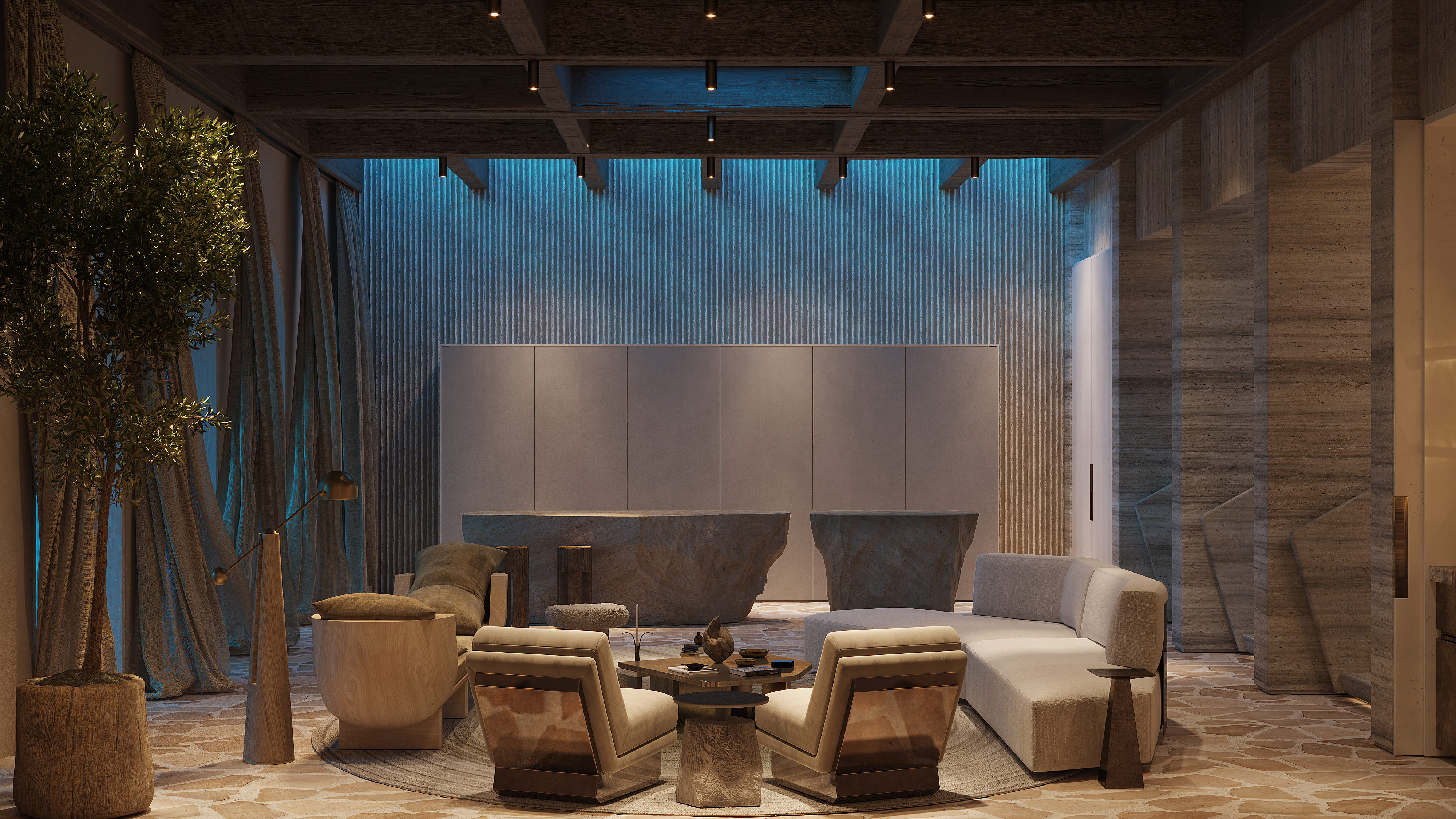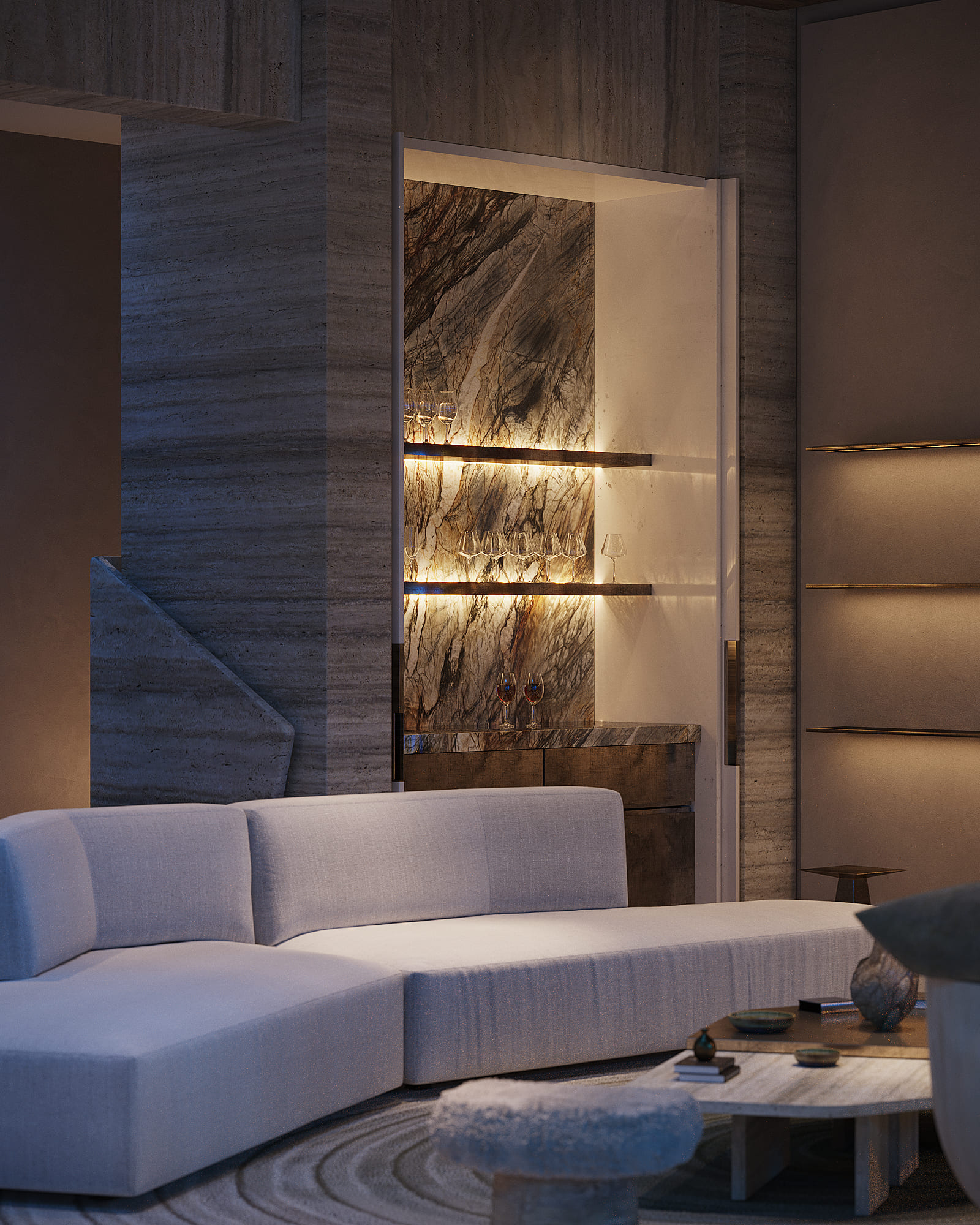A Belief in Walls: Cultural lens in design
"Space is not made. It is revealed — by the way people live, believe, and experience.”
Moroccan architecture-inspired courtyard, part of a renovation project for a villa in Abu Dhabi, designed by Nemov.
Designing for People, Not Just Places
There are houses you walk into and forget as soon as you leave. And then there are rooms that linger – not because they are perfect in proportion or filled with exquisite furniture, but because they feel alive.
It is all about people – how they choose to live their lives and experience the world. The spaces we create are never static or sterile; they are treated as living instruments meant to spark joy, foster intimacy, and elevate everyday rituals. A morning coffee, the quiet echo of a hallway, the way a family gathers around a table – these simple moments become the true measures of design.
This echoes what leading voices in design emphasize today.
It is all about people – how they choose to live their lives and experience the world. The spaces we create are never static or sterile; they are treated as living instruments meant to spark joy, foster intimacy, and elevate everyday rituals. A morning coffee, the quiet echo of a hallway, the way a family gathers around a table – these simple moments become the true measures of design.
This echoes what leading voices in design emphasize today.
The House as a Cultural Instrument
“A majlis or a courtyard is never just a room – it is a cultural vessel, charged with memory and continuity.”
Culture is not decoration. It istransmission tool. It carries values, habits, and ways of living. carryingvalues, behaviors, and rituals from one generation to the next.
In Arab families, this is clearest in the majlis. Once an outdoor gathering space where tribal elders debated and resolvedmatters of community, it has evolved into a dedicated room within the home. Yetthe role is unchanged – it remains a space of welcome, of conversation, and ofhospitality. Guests are still greeted with Arabic coffee, served in ritualorder, binding past to present.
Equally central is the courtyard. Traditionally, it was the nucleus of Middle Eastern homes – a shaded open-air room around which family life unfolded. Meals, celebrations, storytelling all converged there. Today, in climates like United Arab Emirates or Saudi Arabia, courtyards continue to anchor the house – places of gathering, of children’s play, of evenings when heat gives way to breeze.
What emerges is a choreography of togetherness. Spacesremain adaptable: they can unite large groups, create smaller circles, or allowmoments of solitude. Architecture becomes not a fixed container, but a scriptfor collective life.
In Arab families, this is clearest in the majlis. Once an outdoor gathering space where tribal elders debated and resolvedmatters of community, it has evolved into a dedicated room within the home. Yetthe role is unchanged – it remains a space of welcome, of conversation, and ofhospitality. Guests are still greeted with Arabic coffee, served in ritualorder, binding past to present.
Equally central is the courtyard. Traditionally, it was the nucleus of Middle Eastern homes – a shaded open-air room around which family life unfolded. Meals, celebrations, storytelling all converged there. Today, in climates like United Arab Emirates or Saudi Arabia, courtyards continue to anchor the house – places of gathering, of children’s play, of evenings when heat gives way to breeze.
What emerges is a choreography of togetherness. Spacesremain adaptable: they can unite large groups, create smaller circles, or allowmoments of solitude. Architecture becomes not a fixed container, but a scriptfor collective life.
Craft, Integrity, and Materiality
We believe that design must also be anchored in craft. Sometimes it comes from lineage – the family of boatbuilders, or the son of a marble mason who spent his childhood watching stone being cut, polished, and shaped into sculpture. From such beginnings comes an appreciation for precision, tailoring, and integrity in making. This ethos in forms our interiors, where we embrace the belief that authenticity lies in materials treated with respect – wood, plaster, and stone that carry weight, texture, and permanence.
We are moving into an era thatvalues simplicity, where subtle materials are invited to blend with nature rather than dominate it. This shift echoes a global movement towards quiet luxury – spaces that whisper sophistication rather than shout it.
These values are not abstract. They are lived traditions across the Mediterranean. In Sicily, families still prepare recipes unchanged for more than a thousand years – continuity preserved through taste. On Ibiza, vernacular dry-stone walling endures as a building method, embodying resilience and honesty.
In the Greek or Ibiza islands, terrazzo remains a humble yet enduring surface. Together, these practices remind us that design at its best is not invention – it is preservation, carried forward with carein to the present.
We are moving into an era thatvalues simplicity, where subtle materials are invited to blend with nature rather than dominate it. This shift echoes a global movement towards quiet luxury – spaces that whisper sophistication rather than shout it.
These values are not abstract. They are lived traditions across the Mediterranean. In Sicily, families still prepare recipes unchanged for more than a thousand years – continuity preserved through taste. On Ibiza, vernacular dry-stone walling endures as a building method, embodying resilience and honesty.
In the Greek or Ibiza islands, terrazzo remains a humble yet enduring surface. Together, these practices remind us that design at its best is not invention – it is preservation, carried forward with carein to the present.
The Cultural Scenario - The Theatre of Living
This is why Nemov’s work begins not with a plan, but with a scenario. To design for people, one must first imagine a day in their lives – a spatial screenplay.
–Who rises first, and where does the light fall at that moment?
–What sound should a hallway carry – silence or echo?
–Is the table for gathering, or for showing?
Without such questions, even the most elegant layouts remain numb. A house is not defined by its geometry, but by its rhythms. In traditional cultures, these rhythms evolved organically, generation after generation. Today, they must be carefully observed, relearned, and translated into contemporary form.Anthropological attention – listening, watching, understanding rituals – becomes as important to design as drafting.
Our first goal is to be an ethnographer – only we can resonate the architecture. In traditional cultures, these scenarios evolved over centuries. Today, they must be re-learned from observation, from listening, from anthropological attention— not mood boards.
–Who rises first, and where does the light fall at that moment?
–What sound should a hallway carry – silence or echo?
–Is the table for gathering, or for showing?
Without such questions, even the most elegant layouts remain numb. A house is not defined by its geometry, but by its rhythms. In traditional cultures, these rhythms evolved organically, generation after generation. Today, they must be carefully observed, relearned, and translated into contemporary form.Anthropological attention – listening, watching, understanding rituals – becomes as important to design as drafting.
Our first goal is to be an ethnographer – only we can resonate the architecture. In traditional cultures, these scenarios evolved over centuries. Today, they must be re-learned from observation, from listening, from anthropological attention— not mood boards.


The Kitchen Scenario – From Ritual to Silence
In the morning, the kitchen island becomes a place of rhythm and use. Cabinets behind it open to reveal cups, bread, fruit – the quiet choreography of preparing breakfast. The island is not simply a surface, but a stage for movement, light, and scent. It is the architecture of daily ritual, alive with purpose.
By evening, the rhythm changes. Cabinet doors stay closed, counters are cleared, and the kitchen recedes into the background. The island no longer asks for attention – it becomes a silent backdrop, allowing the focus to shift to the seating area where conversation takes over. Function gives way to presence, and the space transforms from utility to atmosphere.
By evening, the rhythm changes. Cabinet doors stay closed, counters are cleared, and the kitchen recedes into the background. The island no longer asks for attention – it becomes a silent backdrop, allowing the focus to shift to the seating area where conversation takes over. Function gives way to presence, and the space transforms from utility to atmosphere.


The Minibar Scenario – Hidden in Daylight, Revealed at Night
At daybreak, the minibar disappears. Its doors remain closed, blending with the travertine walls until it is almost invisible. In the stillness of morning, when it is not needed, it becomes architecture – a quiet plane of stone, carrying no weight beyond its surface.
At night, the ritual reverses. Pocket doors slide open and the minibar reveals its purpose – shelves lined with bottles and glasses, waiting for use. As guests settle into the seating area, the minibar shifts into function, becoming a discreet companion to hospitality. The sound of glass, the pouring of a drink, the act of serving – all transform the once-hidden wall into a stage of gathering.
At night, the ritual reverses. Pocket doors slide open and the minibar reveals its purpose – shelves lined with bottles and glasses, waiting for use. As guests settle into the seating area, the minibar shifts into function, becoming a discreet companion to hospitality. The sound of glass, the pouring of a drink, the act of serving – all transform the once-hidden wall into a stage of gathering.
A Practice of Stories and Humanity
Nemov philosophy is not a style but a worldview. It is about stories, people, and culture. It is about finding the balance between restraint and expression, between heritage and innovation, between global influences and intimate human needs.
In our words and in our work, design becomes more than a visual exercise—it becomes a vessel for memory, emotion, and possibility. Their interiors are not backdrops for life; they are stages where culture, art, and humanity converge.
Nemov’s philosophy is not a style –it is a worldview. It is about stories, people, and culture. It seeks balance between restraint and expression, between heritage and innovation, between global currents and intimate family rituals.
In our work, walls are not simply boundaries – they are beliefs. Courtyards are not voids – they are stages for memory. Majlis are not reception rooms – they are instruments of hospitality, identity, and continuity.
We are not trying to follow trends but tell stories – vessels for memory, emotion, and possibility. They are not backdrops for life, but living stages where culture, art, and humanity converge.
In our words and in our work, design becomes more than a visual exercise—it becomes a vessel for memory, emotion, and possibility. Their interiors are not backdrops for life; they are stages where culture, art, and humanity converge.
Nemov’s philosophy is not a style –it is a worldview. It is about stories, people, and culture. It seeks balance between restraint and expression, between heritage and innovation, between global currents and intimate family rituals.
In our work, walls are not simply boundaries – they are beliefs. Courtyards are not voids – they are stages for memory. Majlis are not reception rooms – they are instruments of hospitality, identity, and continuity.
We are not trying to follow trends but tell stories – vessels for memory, emotion, and possibility. They are not backdrops for life, but living stages where culture, art, and humanity converge.